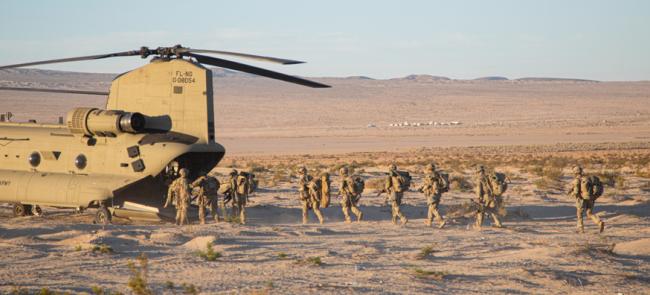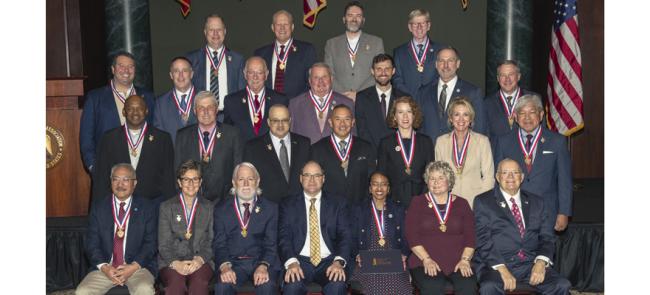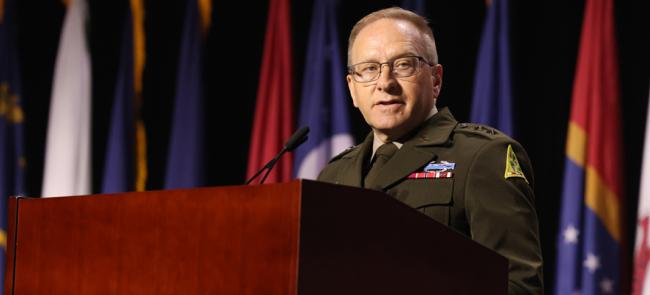
Big Change
LOUISVILLE, KENTUCKY — Kentucky is synonymous with horse racing and the Kentucky Derby. So it should be no surprise that the Kentucky Air National Guard’s newest thoroughbred is named after a winner of the first jewel of the sport’s Triple Crown, Behave Yourself in 1921.
Lt. Gen. Michael A. Loh, the director of the Air National Guard, piloted the C-130J-30 Hercules, the latest variant of the venerable cargo plane, straight from the Lockheed Martin assembly plant in Marietta, Georgia, to the Guard base at Muhammad Ali International Airport here Jan. 7.
It was the third of eight such aircraft the unit will receive this year. The first two arrived in early November. They honor American Pharoah, winner of the 2015 Triple Crown, and Silver Charm, who won the Derby and Preakness titles in 1998.
“It had nine hours on it when I picked it up,” Loh said of Behave Yourself. “It smelled like a new car. Everything was clean. Everything was pristine. It was great. Lockheed gave us a great product.”
The new aircraft are replacing eight H-model C-130s that had been with the unit since 1992. They were more workhorse than thoroughbred. The 123rd flew them regularly across the country and around the world, including multiple missions in Iraq and Afghanistan.
The wing is one of three Guard Herc units converting from H models to the new variant this year. The 130th Airlift Wing in West Virginia and the 136th Airlift Wing in Texas are on a similar schedule.
They were selected following a lengthy competition among Guard Herc units in eight states. The National Guard Bureau, Air Mobility Command and Department of the Air Force evaluated a variety of criteria, including current facilities, aircraft maintenance capabilities and operational history, prior to the November 2020 announcement.
The 123rd’s credentials included 19 Air Force Outstanding Unit Awards.
“I can tell you that the competition for these planes was intense,” Sen. Mitch McConnell, R-Ky., the Senate minority leader, who was among the dignitaries in attendance when the first J models arrived. “And it is extremely gratifying to see this come together. This is incredibly important to our state and to our national reputation.”
The J-30 is often referred to as the “stretch model.” It is 15 feet longer than other C-130 variants, which enables it to carry two more full pallets of supplies or 38 more troops. Nevertheless, it flies faster and father and requires less distance for takeoff and landing.
It also features the “glass cockpit.” Dozens of analog gauges have been replaced by multifunctional LCD heads-up displays, as well as a digital moving map, a low-power color radar and a dual inertial navigation system. The J-30 also has fully integrated defensive systems.
Master Sgt. Jamie Nalley, one of the unit’s crew chiefs, is smitten. He says the J-30, particularly its Rolls-Royce engines, is “100% better overall.”
“It has a way better motor,” he said. “Way more powerful. Way more maintenance-friendly. Way more fuel-efficient. It’s wonderful.”
But there is little time to sit back and admire the new aircraft. Everyone whose job touches the plane — hundreds of pilots, loadmasters, maintainers and other personnel — has to be retrained. The aircraft may be a C-130, but it is far more complex than those they gave up.
In addition, base facilities have to be adapted to accommodate the bigger and more modern aircraft. The entire process officially began Aug. 1 and is expected to take three full years.
“From the moment when we got the announcement, there’s a lot of stuff to do,” says Lt. Col. William “Penn” Brown, the commander of the wing’s 165th Airlift Squadron. “We physically modified the workspace [at the base] to maximize efficiency and to make sure that, in this new J-model-operated environment, that we’re using the space as best we can.”
Retraining is accomplished at other bases. Pilots and loadmasters go to Little Rock Air Force Base, Arkansas. The pilot transition course is four to six months, depending on the experience level. Loadmaster training is roughly two months. Maintainers go to Quonset Point Air National Guard Station, Rhode Island, for three months. It is home of the 143rd Airlift Wing, one of only two Guard units that previously operated the C-130J.
Col. Bruce Bancroft, the wing commander, says the conversion has gone “better than expected.”
“One of my big concerns initially was whether or not we’d have the crews and the maintainers to be able to support [the aircraft] early in the game,” he says. “We’ve done an incredible job working with our functional managers about securing [school] slots. The number of [personnel] positions we’ve received has been fantastic. And we’re actively recruiting out of active-duty right now at an enormous rate.”
From the moment when we got the announcement, there's been a lot of stuff to do.
—Lt. Col. William "Penn" Brown, the commander of the Kentucky Air National Guard's 165th Airlift Squadron
AIR FORCE OFFICIALS and the Air Guard director decided the ultimate destinations for the 24 J-30s. The service provided eight aircraft from active-component stock, but Congress did much of the rest.
The Air Force hasn’t included C-130s in its annual budget requests for several years, in part because every active-component Herc unit already has J models. The service has also prioritized new fighters and tankers and the development of a new bomber in its recapitalization plans.
Congress, which ultimately determines all government spending, stepped in, adding 24 J-30s to final defense appropriations for the Guard from 2017 to 2021 at the request of Guard leaders and NGAUS. Sixteen are part of the three conversions, which have enabled the Guard to shed some its oldest H models, which were manufactured in 1974.
The other eight J-30s will go to Arkansas’ 189th Airlift Wing (two), which serves as the Guard’s J-30 schoolhouse, and Georgia’s 165th Airlift Wing (six) sometime over the next few years.
Lawmakers also added 16 J-30s for the Guard to the final 2022 spending plan passed early this month. They are enough for two more Guard airlift units to convert to new aircraft.
Currently, the Guard still has eight C-130 wings with aging H models in need of new engines, propellers and avionics. Some of the modernization is ongoing, says Col. Stephen R. Gwinn, the chairman of the NGAUS Airlift Task Force and commander of Connecticut’s 103rd Airlift Wing, funded largely through congressional add-ons and the congressionally directed National Guard and Reserve Equipment Account.
The number will drop to seven when Ohio’s 179th Airlift Wing converts to a nonflying cyber wing as scheduled later this year. It could drop even further if Air Force leaders get Congress to agree to reduce the service’s overall number of C-130s. Any cuts would come from units flying H models, which are all in the Guard and Air Force Reserve.
Guard leaders, including Gen. Daniel R. Hokanson, the NGB chief, believe the service’s calculus does not factor in the Guard’s domestic airlift missions. They also think the remaining H models have plenty of valuable life in them if fully modernized, which is why they have been working on modernizing the fleet for the better part of two decades.
Way more powerful. Way more maintenance-friendly. Way more fuel-efficient.
—Master Sgt. Jamie Nalley, a crew chief for the Kentucky Air National Guard's 123rd Airlift Wing
WHILE UNIT PILOTS are excited about the arrival of the J-30s, Brown, the commander of the wing’s airlift squadron, says some were sad to see the H models go.
“We have people who have done nothing but fly the C-130H their entire time in the Guard,” he says. “A lot of our folks started in maintenance working on these things. Their heart and souls are in those things. It was painful to watch them leave.”
Nalley, one of the crew chiefs, adds that unit personnel are in the crawl phase of the crawl-walk-run process of learning a new aircraft.
“I sat all my people down and said, ‘We’re going to go slow and we’re going to read every step in that book,’” he explains. “And I said, ‘Once you start feeling you know something, that’s when you really need to pay attention.’ That’s when you get dangerous, when you think you got it.”
Nalley called the conversion to J-30 “humbling.”
“I haven’t felt the fear that I was going to mess something up since I was in my 20s,” he adds. “You get so comfortable working on [the H-model] and you’re holding everybody’s lives in your hands all the time. You always have to keep that in the front of your mind. That way you don’t hurt nobody. That’s the No. 1 thing.”
The conversion has also altered the size of the air crews. Advanced technology has eliminated the need for a navigator and a flight engineer. All of the in-flight navigation along with the monitoring of various aircraft systems is automated on the J-30, which reduces the crew from five or six to three.
“It was weird, the other night on my first local mission back from training, it was me, one other pilot and a load master and that’s it,” Brown says. “That’s a huge culture change from having six people on that plane and it’s going to be more evident as we start taking those next baby steps to taking these planes on the road and going to do airlift trips and going to do air drops down at Ft. Benning, Georgia.”
The change also means that navigators and flight engineers need to find a new job to stay in the wing.
Capt. Jason Ketterer, who has been a C-130 navigator for eight of his 18 years in the Air Guard, says he plans to go to flight school and become a pilot. But some other navigators are heading elsewhere, either to H-model units or retirement.
“While you have a lot of opportunity for yourself personally, there is also loss because these are people that you have trained with, served with, gone to deployments with,” Ketterer says. “You know they’re not going to be moving on to that next phase.”
Brown says the unit is doing a good job of handling this aspect of the conversion.
“We’re going to have some people who are going to have to retire because of this conversion,” he says. “We’re going to have to have some people go to other units if they want to stay flying. We’ll have other people find other jobs within the wing. With every big change comes challenges, but it also has some incredible opportunities for folks who might not have gotten that opportunity otherwise if it weren’t for the conversion.
“And I think we all recognize that we need to move forward with something that’s going to be kept in the fight.”
Or, in horseracing lexicon, a thoroughbred that can post for the next big race.
Donald Lambert, the NGAUS staff writer, can be reached at [email protected].
AT A GLANCE: C-130 Hercules
C-130H
Length: 97 feet, 9 inches
Height: 38 feet, 10 inches
Wingspan: 132 feet, 7 inches
Power Plant: Four Allison turboprops
4,591 prop shaft horsepower
Max Load: Six pallets, 74 liters
92 combat troops
15 container system bundles or 64 paratroops
Crew: Five (two pilots, navigator, flight engineer & loadmaster)
Speed: 366 mph/318 ktas
Range: 1,208 miles
C-130J-30
Length: 112 feet, 9 inches
Height: 38 feet, 10 inches
Wingspan: 132 feet, 7 inches
Power Plant: Four Rolls-Royce turboprops
4,700 horsepower
Max Load: Eight pallets, 97 liters
128 combat troops
24 container system bundles or 92 paratroopers
Crew: Three (two pilots & loadmaster)
Speed: 410 mph/356 ktas
Range: 1,956 miles
Source: Air Force
C-130J Aircraft Conversions Help Other Guard Herc Units
C-130J conversions in Kentucky, Texas and West Virginia are having positive ripple effects across Guard Hercules units nationwide.
Connecticut’s 103rd Airlift Wing and Montana’s 120th Airlift Wing operate aircraft that recently belonged to Texas and West Virginia. And Delaware’s 166th Airlift Wing has Kentucky’s old Hercs. Each gained newer and more advanced aircraft.
The aircraft transfers have enabled the Guard to shed the last of the oldest C-130s in the Air Force inventory. The 103rd and 120th wings had H1-model C-130s that Lockheed Martin built in 1974. Now, they have H3s that were manufactured in the early 1990s.
H-model C-130s look almost identical from the outside. The difference is inside. The H3 includes ring laser gyroscopes for the inertial navigation system, GPS receivers, night-vision- device-compatible instrument lighting, and an integrated radar and missile warning system.
“It’s a big deal when you’re in the airplane and flying, because it’s a much better system,” says Col. Stephen R. Gwinn, the commander of the 103rd and the chairman of the NGAUS Airlift Task Force. “It’s a lot more accurate, so it actually is going to keep us safer when doing things like flying in the weather or flying in formation.”
H3s also have significantly less wear and tear. The aircraft the 103rd received have about 10,000 flight hours each or about a third of the hours that were on the wing’s old H1s, says Col. Thomas Olander, the 103rd vice commander, who headed the wing’s maintenance group when the H3s began to arrive last summer.
“From a maintenance perspective, I would equate this to working on a 1974 car and trying to find the pieces and parts, versus working on a car from the early to mid-90s,” he said last summer when the H3s began to arrive.
“You’ll get more productivity out of the airplanes because they’ll require a lot less man hours to fix and get over to operations, which means that our execution rate in the operations group will be that much better,” Gwinn says. “The capabilities that we gain bring the risk down, and it’s all about risk management.”
“Then, last but not least,” he adds “there’s actually a toilet in this airplane, which is a big deal for our female crew members and all of our crew members for our long flights across the ocean and traveling around the world.”
But the H3 is still a 20th-century aircraft, one the active component no longer flies and in need of significant modernization to remain relevant in the years ahead, Gwinn says.
The H1s the H3s replaced are now in the aircraft boneyard or heading overseas as part of foreign military sales.
— Some reporting by Master Sgt. Tamara Dabney



